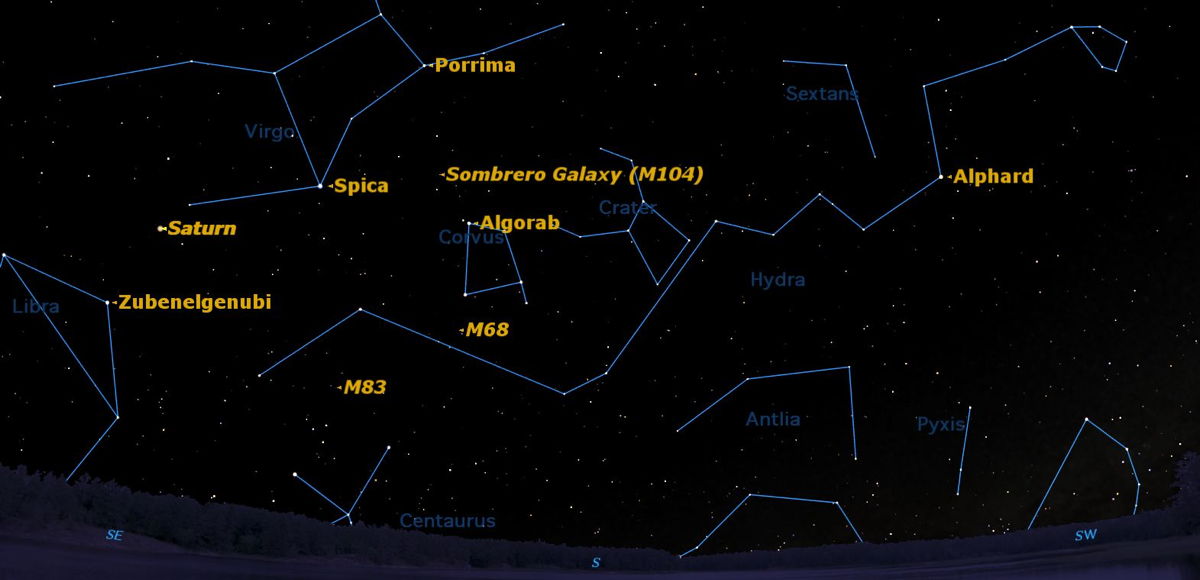See a Celestial Circus Below Saturn This Week

Lately, Saturn has been rising in the east before midnight, putting it in just the position to serve as a guide to the astronomical treasures hidden below it.
Saturn is currently on the border between the constellations Virgo and Libra. Virgo features the bright first-magnitude star Spica (on astronomers' magnitude scale, the lower the number, the brighter the star), slightly less luminous than Saturn just to its left, called the east by astronomers because it is closer to the eastern horizon.
Immediately below Saturn and Spica is the little known constellation Hydra, the Sea Snake. Except for its brightest star, second-magnitude Alphard, the stars of Hydra are faint and hard to see except from dark country locations. Despite being inconspicuous, Hydra is the largest constellation in the sky, both in area and in length. It's a real treat to see it in a dark sky and trace its graceful undulations across the southern horizon. [Stargazing Events for May 2013 (Sky Maps)]
Riding on Hydra's back are two oddities, a cup and a crow. The myth has it that a crow was asked by Apollo for a cup of water. In an effort to fool Apollo, the crow put a water snake in the cup instead. The god was so angry that he flung all three into the sky: crow, cup, and snake.
Corvus the Crow doesn't look much like a crow; its slightly skewed rectangle of stars resembles a lateen sail, so mariners used to call it "Spica's Spanker," a spanker being the aft-most sail on an old sailing ship. Its brightest star Algorab is a pretty double star, its 3rd- and 9th-magnitude components distinguishable by even a small telescope because of their wide separation: 24 arc-seconds. A chain of stars just above Algorab leads the way to a tiny arrow, which points at the heart of the Sombrero Galaxy, one of the brightest galaxies in the sky.
Directly above the Sombrero is the double star Porrima, Gamma Virginis. In recent years the identical twin stars of this binary star were too close to split, but recently they have moved apart so that they can be seen to be double in at least a 3-inch telescope.
The two stars on the left (eastward) side of Corvus point southward to Messier 68 in Hydra, one of the finest globular star clusters in the sky.
Get the Space.com Newsletter
Breaking space news, the latest updates on rocket launches, skywatching events and more!
Follow the two stars at the bottom of the Corvus sail to the left to reach Gamma and Pi Hydrae. Below these hangs a fine bright galaxy, Messier 83, sometimes called the Southern Pinwheel. This is often a difficult target for northern observers because of its closeness to the horizon, but viewed from the Southern Hemisphere it reveals itself to be one of the finest galaxies in the sky.
Go any further south from Messier 83, and you'll find yourself in the constellation Centaurus. Observers in the southern part of the United States will be able to see the Hamburger Galaxy, NGC5128, and Omega Centauri, the finest globular cluster in the sky, also known as NGC5139.
Just to the left (east) of Saturn is another double star with the wonderful name Zubenelgenubi, which translates from Arabic as "the Southern Claw," referring back to a time when Libra was considered part of Scorpius. This double is wide enough to be split with a 10x50 pair of binoculars.
So, be sure to augment your observations of Saturn by checking out some of these delightful objects just to its south.
This article was provided to SPACE.com by Starry Night Education, the leader in space science curriculum solutions. Follow Starry Night on Twitter @StarryNightEdu.
Join our Space Forums to keep talking space on the latest missions, night sky and more! And if you have a news tip, correction or comment, let us know at: community@space.com.

Geoff Gaherty was Space.com's Night Sky columnist and in partnership with Starry Night software and a dedicated amateur astronomer who sought to share the wonders of the night sky with the world. Based in Canada, Geoff studied mathematics and physics at McGill University and earned a Ph.D. in anthropology from the University of Toronto, all while pursuing a passion for the night sky and serving as an astronomy communicator. He credited a partial solar eclipse observed in 1946 (at age 5) and his 1957 sighting of the Comet Arend-Roland as a teenager for sparking his interest in amateur astronomy. In 2008, Geoff won the Chant Medal from the Royal Astronomical Society of Canada, an award given to a Canadian amateur astronomer in recognition of their lifetime achievements. Sadly, Geoff passed away July 7, 2016 due to complications from a kidney transplant, but his legacy continues at Starry Night.










